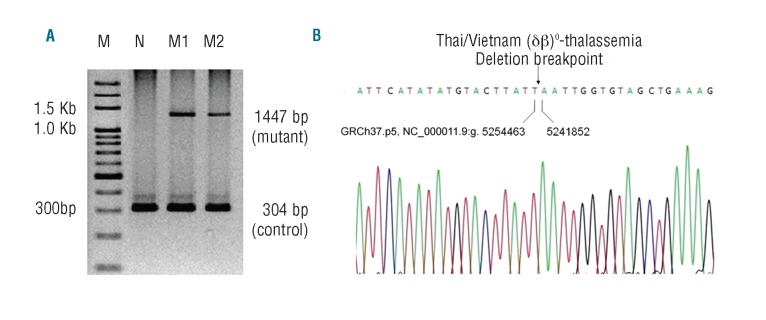A recent publication by Ghedira et al.1 described a cohort of 10 patients with five different types of deletions involving the beta(β) globin gene (HBB) cluster, two of which removed the γ-δβ intergenic region. Heterozygotes for the different deletions have different levels of fetal hemoglobin (HbF). The authors concluded that loss of the BCL11A binding domain located upstream to the γ-globin gene was strongly correlated with HbF production owing to a lack of inhibitory effects of BCL11A. Their data confirmed the initial report of Sankaran et al. In the report by Ghedira et al.,1 five different deletions were described in individuals from various ethnicities, and it was claimed that two deletions (12.6 and 84.8 kb in length) were being reported for the first time. While the association of the 84.8 kb-deletion with hereditary persistence of fetal hemoglobin (HPFH) seemed to be novel, we are of the opinion that the 12.6 kb-deletion might have been a misdiagnosis of a known deletion that has been reported several times: Thai/Vietnamese (δβ)0-thalassemia.2–5 This deletion was first reported by Trent et al. in 19882 and was later confirmed by simple GAP-PCR.3 The deletion was subsequently reported by several groups from Thailand, including us.5 In these previous studies, the GenBank HUMHBB as a reference template and co-ordinate numbers for deletion were 55990–68575del (deletion size; 12,585 bp). Using this template, the co-ordinate 00001 started from the upstream to the β-locus control region (β-LCR). However, in the publication by Ghedira et al.,1 the GRCh37.p5 NC_000011.9 (UCSC and Ensembl genome browser) was used as a template and the deletion extended from co-ordinates 5241853–5254462del with a deletion size of 12,610 bp.
To test whether these two reported deletions were identical, we compared the sequence breakpoints of our known Thai/Vietnamese (δβ)0-thalassemia previously identified by a multiplex GAP-PCR6 (Figure 1A) with those of Ghedira et al. and found that they were both the same (Figure 1B). In addition, we aligned our sequences with the two different templates and the alignment revealed identical co-ordinate numbers, as mentioned above. It would appear that the GRCh37.p5 NC_000011.9 was different in size from the other template, possibly due to the presence of sequence variants. Both contigs have different small nucleotide repeats including: (a)n, (ctagt)n and single or dinucleotides (data not shown). Collectively, these changes could account for the 25 bp-difference between the original reports and that of Ghedira et al. Therefore, we conclude that the 12.6 kb was misquoted as a novel deletion and it was, in fact, the common known Thai/Vietnamese (δβ)0-thalassemia commonly found in Southeast Asia. Recently, we studied 180 Thai individuals with high HbF and identified 28 cases (15.5%) with this deletion.5 It is plausible that this deletion might be widely spread throughout Asia, from the Indian subcontinent to the East, e.g. Thailand and Vietnam. Also in this report, another 20.7 kb-Turkish deletion/inversion was reported to have been described once in the literature. We would like to point out that this deletion/inversion had been documented several times earlier.7–9
Figure 1.
Characterization of the 12.6 kb-deletion (Thai/Vietnamese (δβ)0-thalassemia) by the multiplex GAP-PCR (A) and breakpoint sequencing (B).
More than 80 deletions involving the HBB cluster have been reported thus far and these result in a variety of clinical phenotypes from thalassemia-like to HPFH.10 Due to a lack of a standardized database and the use of different reference templates, it is easy to make a mistake in the reported sizes of these deletions. Appropriate studies of these globin gene rearrangements in cis together with trans acting loci further improve our understanding of the complexity of γ globin gene regulation.
Footnotes
Information on authorship, contributions, and financial & other disclosures was provided by the authors and is available with the online version of this article at www.haematologica.org.
References
- 1.Ghedira ES, Lecerf L, Faubert E, Costes B, Moradkhani K, Bachir D, et al. Estimation of the difference in HbF expression due to loss of the 5′ δ-globin BCL11A binding region. Haematologica. 2013; 98(2):305–8 [DOI] [PMC free article] [PubMed] [Google Scholar]
- 2.Trent RJ, Svirklys L, Jones P. Thai (δβ)0-thalassemia and its interaction with gamma-thalassemia. Hemoglobin. 1988;12(2):101–14 [DOI] [PubMed] [Google Scholar]
- 3.Craig JE, Barnetson RA, Prior J, Raven JL, Thein SL. Rapid detection of deletions causing δβ thalassemia and hereditary persistence of fetal hemoglobin by enzymatic amplification. Blood. 1994; 83(6):1673–82 [PubMed] [Google Scholar]
- 4.Fucharoen S, Pengjam Y, Surapot S, Fucharoen G, Sanchaisuriya K. Molecular characterization of (δβ)(0)/β0)-thalassemia and (δ–β))(0)-thalassemia/hemoglobin E in Thai patients. Eur J Haematol. 2001; 67(4):258–62 [DOI] [PubMed] [Google Scholar]
- 5.Chalaow N, Riolueang S, Karnjanakorn C, Limwongse L, Viprakasit V. Molecular Characterization of Postnatal Expression of Gamma Globin Genes due to Deletions involved the β globin gene cluster in Thailand. In: Lin KH, Lu MY. (eds.). The 3rd Asia Pacific Iron Academy Conference (APIA); Exchanging expertise in iron science and research The Grand Hotel, Taipei, Taiwan: Taiwan Society of Blood and Marrow Transplantation and APIA; 2012:37 [Google Scholar]
- 6.Tritipsombut J, Phylipsen M, Viprakasit V, Chalaow N, Sanchaisuriya K, Giordano PC, et al. A single-tube multiplex gap-polymerase chain reaction for the detection of eight β-globin gene cluster deletions common in Southeast Asia. Hemoglobin. 2012; 36(6):571–80 [DOI] [PubMed] [Google Scholar]
- 7.Craig JE, Efremov GD, Fisher C, Thein SL. Macedonian (δβ) zero thalassemia has the same molecular basis as Turkish inversion-deletion (δ β) zero thalassemia. Blood. 1995;85(4):1146–7 [PubMed] [Google Scholar]
- 8.Oner C, Oner R, Balkan H, Gürgey A, Yalçin A, Avcu F, et al. Molecular analysis of the Turkish form of deletion-inversion (δβ)(0) thalassaemia. Br J Haematol. 1997;96(2):229–34 [DOI] [PubMed] [Google Scholar]
- 9.Samara M, Chiotoglou I, Kalamaras A, Likousi S, Chassanidis C, Vagena A, et al. Large-scale population genetic analysis for hemoglobinopathies reveals different mutation spectra in central Greece compared to the rest of the country. Am J Hematol. 2007;82(7):634–6 [DOI] [PubMed] [Google Scholar]
- 10.Thein SLWW. The molecular basis of β thalassemia, δβ thalassemia, and hereditary persistence of fetal hemoglobin. In: Steinberg MHFBH, Weatherall DJ. Disorders of Hemoglobin. 2nd ed. Cambridge University Press; 2009:325–56 [Google Scholar]



